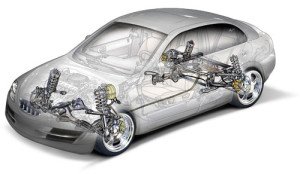Suspension problems of your car
Your car’s suspension is one of the most important auto systems installed in your car. It’s the part of your ride that keeps your car’s body connected to your wheels. The suspension also has the vital job of dampening the up and down movement created by your car’s leaf springs each time your ride passes through road irregularities. It basically controls the automatic, bouncing movement, to make your travels a lot more comfortable and stable.
Each time you travel, your suspension system undergoes road abuse brought by adverse road conditions and even “extreme driving”. Now imagine the amount of force the suspension system had to withstand when you hit the brakes without warning.
While your car’s suspension system is designed to be extremely hard wearing, expect tough road abuse to eventually wear out some of your suspension parts. To avoid a complete auto breakdown, troubleshoot your suspension the moment you notice something different with how your car travels—excess bouncing, bottoming out, etc.
• To save more money, I recommend habitually checking your suspension for signs of problems—this way, you can easily address minor suspension issues before they become full-blown suspension problems. In my previous post on checking your car’s exterior, I gave one tip on how you can check the state of your suspension, and that’s by “bouncing” your car. You’ll stand over at one end of your car, your assistant will stand at the other. At the same time, apply pressure on your car’s trunk and hood. This should let your car bounce a little. It should not bounce too much. If it continues bouncing even after a while, then that’s a sign of suspension troubles.
Check the following symptoms:
• “Check the visible connections of your suspension. Your suspension problems might just be caused by loose or damaged connections.” Before taking your car to the service center and having multiple parts replaced, check what you can and suggest to your mechanic what you think the problem might be.
• “Wheel shimmy” is one of the terms we use to describe the back and forth movement created by your wheels as you drive—and no, this is not a good sign or a common thing. When your wheels rapidly go from one side to the other, even when you’re driving on even roads, then you could have either one of the following:
1. At least one rapidly deflating tyre — at which point, you’ll have to inflate that tire as soon as possible.
2. Your wheels are no longer aligned.
3. It’s a steering problem. If your wheels and tires are fine
4. Excessive and/or uneven wear in your tires. Check your tires for signs of excessive wear and damage.
5. Unbalanced wheels. Take your car to the Service Station to have your wheels restored to their original position.
Source: http://automechanics.wordpress.com/2008/10/08/car-maintenance-101-diagnosing-your-suspension-problems-part-i/
